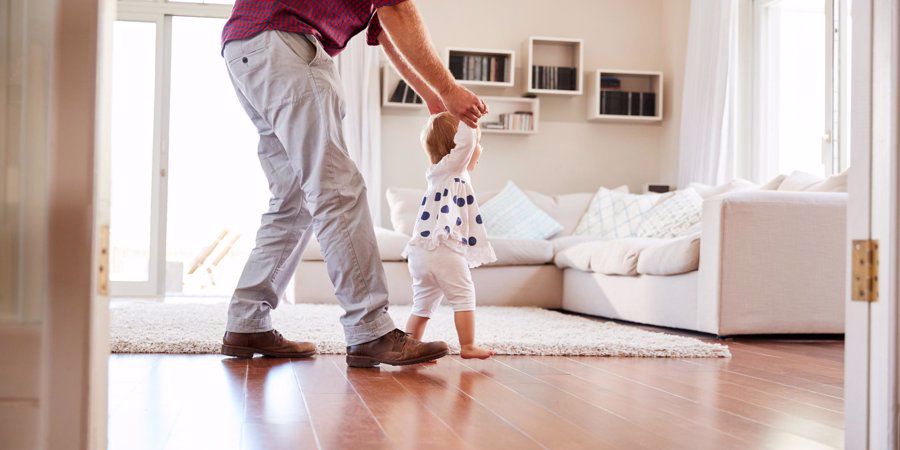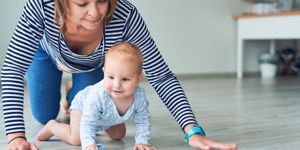Even in the womb your baby is always on the move, and rolling, crawling and walking are major milestones for your baby. Here we give you a useful guide on what to expect and how you can help your baby. Please remember that all babies develop at their own levels, so your baby may not exactly fit into the timescales below. If you have any concerns about your baby’s development, please talk to a medical professional.
[Read more: Your Baby's Development - 6 to 18 months]
Rolling Over
This is the first major movement that your baby will do and usually happens around four months. Your baby is likely to start with rolling from his tummy onto his back first, and then back to tummy. A full roll will follow soon after!
The best way you can help your baby roll over is to encourage plenty of tummy time, which is when you lay them on their tummy on the floor. Using a brightly coloured mat and sensory toys encourage your baby to lift their head, which is crucial for improving neck muscles. This will help your baby to be able to hold their head up independently and control it. It will start with your baby lifting their head slightly, and as they practice more, they will be able to lift their head and push up with their arms and hands.
There are plenty of other benefits of tummy time, not least that it gives your baby a different view. You can start tummy time with your baby from as early as four weeks, just for a few minutes at a time. Some babies don’t enjoy tummy time at first. It’s important to keep going with it but stop if your baby gets too upset.
Shortly after your baby gets the hanging of rolling, they will also be mastering sitting up by themselves. This will include being able to control their head. You can help your baby with sitting by supporting them with pillows or cushions when they are upright. This helps them to stay in the right position but also provide a soft landing if they fall. Eventually, your baby will learn that they can support themselves with their hands on the floor. Once your baby is comfortable with sitting up, you can encourage the development of their back and trunk muscles by placing toys just out of reach, including to the side. You might need to continue with the cushions for this stage, in case they lose balance while turning.
Being able to sit independently and hold their own head are key precursors to weaning, as this allows your baby to have the right position for digesting their food.

Crawling
Following on from rolling and sitting comes crawling. It usually happens around eight or nine months, although some parents wish that it came later! Crawling is one of the big milestones that bring about a big change for the whole family. It may be the case that your baby misses out the crawling stage completely and moves straight on to walking.
There are a few ways to encourage your baby to crawl. Try to limit the amount of time that they are spending sitting in baby seats or chairs. Instead, opt for plenty of time on the floor on both their tummy and their back. This will prompt your baby to move their arms and legs, and you will often see them try out the ‘skydive’ position. Whilst it can be very tempting to move their limbs into the right angles, let your baby work it out for themselves.
You can also encourage them by placing toys or other items out of reach so that they have to move to get them. Make sure you involve the whole family in this. In many families, a baby with an older sibling crawls at a later age because they have lots of family members around to fetch and carry for them.
Crawling itself can take many forms, and doesn’t necessarily replicate a cat or dog! Your baby may shuffle along on their bottom, or adopt a ‘commando’ crawl using their forearms to pull themselves along. Once your baby is confident with crawling, why not try out a mini obstacle course made from cushions or pillows, with plenty of ‘treats’ to find along the way. You may find that when your baby starts crawling a lot it tires them out and they nap more or go to sleep earlier. This stage doesn’t last long.
From a safety perspective, make sure that your floor is clean when your baby is laying down or use a special mat or rig. There are many wipe clean versions available which are great for spills and accidents. You also need to ensure that there are no small or dangerous objects within reach. Don’t assume that your baby will only start crawling when you are watching them, so its best to keep things at baby-level clear as soon as you can.
Standing Up
Depending on how your baby decides to crawl, you may also see them start to pull themselves up to standing. At first, this will be using furniture and other objects, and he may start to move along the item practising his steps. Your baby may attempt to let go but will need to work on his balance a lot to avoid toppling over.
You can help your baby with this stage by offering your hands for them to pull up on, and then helping them to take slow steps forward. Your baby may get ‘stuck’, this is when they can pull themselves up but are not sure how to get back down again. Show them gently how to bend their knees and sit down on their bottom. Hover your hand nearby in case of falls whilst they practice this, but they will develop it quickly.
At this stage, it’s also very important to ensure that there are no dangerous objects around and that anything that could be used as a ‘pull up post’ is secure and cannot be toppled over. Take extra care with open drawers in cabinets or chest of drawers for example.

Walking
Next, it’s the big one! Your baby is likely to start walking independently from around twelve months onwards, but they will start practising before that. Most babies will be walking in a coordinated way from about 15 months but it can come later than that, especially if your baby is a speedy crawler.
There are lots of ways that you can encourage your baby to walk
- holding on to your two hands and taking small slow steps is a great way to build confidence, and you can move to one hand and then one finger as you progress
- you could also get a walker or trolley, which function as a fun toy too. Make sure that the height is right for your baby, there is wide support at the bottom and that the wheels can’t turn too fast. Many experts argue that walkers are not good for your child’s physical development, but as long as your child is placing their feet and legs correctly it shouldn’t have a negative impact. Always supervise your baby when they are using a walker in case of falls.
- encouraging your baby to take steps by themselves by standing a few paces away and offering lots of encouragement.
Try not to have expectations about when your child will start walking, especially if they have older siblings. It may be the case that your baby takes a few steps by themselves and then nothing again for a few days or weeks. Be patient and don’t try to rush them. Your baby may also revert to crawling even when they are successful at walking, as this is how they are comfortable moving around. Try to positively enforce that walking is best, and the crawling won’t last long.
Footwear
Keeping your child barefoot as much as possible helps them to move around more freely, as they can feel their environment. If you are taking your child outside or they are in childcare you may need to use socks or soft shoes. For crawlers and early walkers choose as soft a sole as possible, and only move to ‘proper’ shoes when your child is walking by themselves confidently. When you do purchase shoes, aim to get your child measured and fitted for their shoes so that you can ensure a comfortable fit. Children’s feet vary a lot in terms of width as well as length.
Helping your baby to move around, whether it’s rolling or walking, is one of the key stages in your little one moving from being a baby into a toddler. Although it does require a lot of patience for parents, the moment that your child takes their first tentative steps into your arms is well worth the wait.




